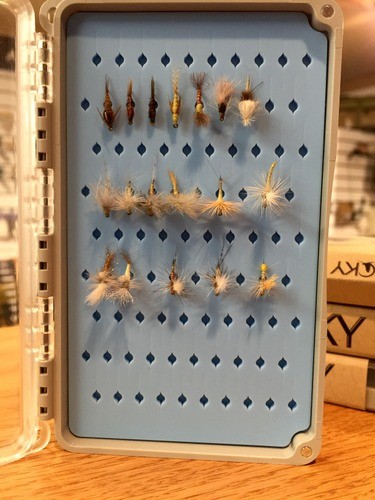Late June and PMDs on the Paradise Valley Spring Creeks are typically synonymous. There has been no exception thus far. PMDs actually were seen, albeit just here & there over 2 weeks ago. It’s been fairly light as far as angler traffic until last week when things really started to fill-in. This week however both the mayflies and the anglers are here in earnest.. If you haven’t gotten reservations to fish Depuy’s, Nelson,or Armstrong for just about any day between now and end of July, good luck! Reports on all 3 spring creeks have been good to very very good. Fish are keyed and focused on the PMD hatch which has been quite strong and daily. Mid morning, expect to see fish sliding into their preferred feeding runs and starting to go on the PMD nymphs that are in the drift. There has to be an amazing number of drifting nymphs and emergers as these fish are super active. And at times, very approachable and easier to pick off with a well placed nymph/emerger combo subsurface. As the PMDs begin to actually show as duns on the surface, trout will also be seen up top. Switching to a dry emerger, cripple, or dun pattern becomes the choice. And as the hatch intensifies, staying strictly on a single dry fly to sighted fish can be exhilarating. It may not be about numbers but about how each scenario plays out that can make this kind of spring creek fishing so much fun! Watch for fish to become very “techy” as the day slips by. Fish will focus on one life cycle or another. Meaning one fish may have eaten your well presented dun while another shuns it completely and has to be fooled with a CDC cripple instead… This is not uncommon. So stay on your game and be sure to have multiple PMD patterns from emergers all the way through the spinnerfall and be sure to study your target’s riseform and action under the surface if you can.
A word here about fly choice, leaders, tippet, and presentation. You may find yourself having finally fooled a respectable spring creek trout on your 18th fly change….. But did you pause for reflection on how the whole thing started out? Old sayings are true. It’s your presentation perhaps well before the fact that the different fly pattern actually worked…… You will find that your success may increase dramatically on the spring creeks if you hold yourself to a higher level of fly presentation! This STARTS with having a proper spring creek leader and tippet. Not much is discussed about this. It’s always what fly. But the basis for how you get that fly to the trout and present it with your offering plays a huge roll. Leaders will be better on the longer side of things. I like a 10ft at minimum and often go 12ft or longer. Now these leaders are very often tapered down to a 5x , 6x, or even 7x tippet. How does your casting hold up to turning over a 12-14ft leader? Consider starting with a 9ft leader with a longer than normal and slightly heavier butt section. A leader with at least half (50%) butt section before tapering will cast significantly better than one with less. I like a 9 or 10ft 4x nylon leader to start. To this I will add (yes- a brand new leader!) 3ft of 5 or 6x tippet to make that longer leader. This is now a more suitable spring creek leader. So often anglers are using 6x tippet but it’s 16″-20″ maybe. Reality is, that doesn’t cut it for allowing small flies to move on spring creek currents in a life-like manner and it’s no wonder you may be getting snubbed by many of the fish! There’s part I of presentation. Start with the right leader. Part II is getting yourself into a good position. Casually flinging from quartering behind the fish is likely to NOT work. Quartering from above DOWN to the fish will. Teach yourself the art of a slackline reach cast down and across and how to “feed” the appropriate amount of slack into the drift so as to present your offering FLY FIRST. This is hugely important! No drag, no tell-tale leader material in front of the fly, and in the fish’s feeding path is not easy. But do it right, you will be rewarded. AND i will add, as my good friend Mark Raisler of HeadHunters in Craig, MT on the Missouri works to beat into everyone’s head: Make the First Cast be your BEST cast! Words so true….. So, there are 3 parts to the Presentation Equation. And we haven’t’ included a fly. Yet. Proper leader & tippet, proper location to your target, and Best Cast- First. Follow this and be observant as to the target’s behavoir will make picking the right fly much easier….
Our photo today shows a nice little lineup of PMD patterns tried and true on the spring creeks and ones we would not consider ourselves to be without. MVP bugs of choice from top row, L to R:
Wollum’s Spring Creek PMD nymph, Sawyer PT, Sawyer PT Olive, Harrop Short-wing PMD emerger, Kinsey CDC Transitional, Williams CDC Transitional, Harrop CDC Captive Dun. 2nd row: Harrop CDC PMD Dun, Morrish May Day PMD, Harrop Thorax CDC PMD, Cripple Thor CDC, PMD Comparadun, Ext body Parachute PMD. 3rd row: D&D PMD Cripple, Blue Ribbon PMD Cripple, Harrop CDC Rusty Spinner, Harrop CDC PMD Spinner, Hi-viz CDC PMD Spinner.
We will continue to see the PMD hatch on the spring creeks for roughly the next 3-4 weeks. Watch that as you get later into July, the hatch times will vary, the intensity will also vary with one day being quite good and the next several notches less. And the bug size will begin to shift smaller. The early PMDs tend to be as big as 14s with a 16 average and as the hatch progresses, 18s become more common. Certainly the trout become considerably more selective and the axiom of First Cast cannot be stressed enough.
Good luck out there!

